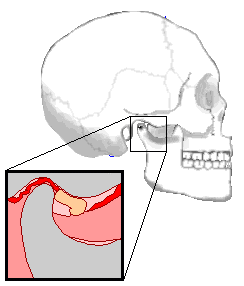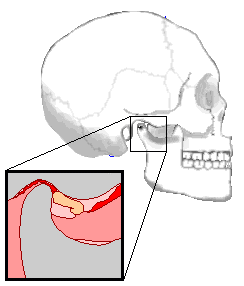TMJ Symptoms
TMJ is an acronym for Temporomandibular Joint. The TM joint system includes both the joints and the teeth. For the system to function correctly, both the teeth and the joints must function in unison. Most often TMJ problems result from the simple fact that when teeth are put together, the TM joints are not in a functionally acceptable position. In fact, this is the major difference between the TMJ and all the body's other joints: Something outside of the joint itself (teeth) can prevent the TM joints from acquiring their best physiological position. The failure of the teeth and TM joints to function in unison results improper sensory input to the muscles, which is the primary cause of muscle tension headaches.
The symptoms most often associated with TMD are ear and joint pain, headaches, joint noise, and uncharacteristically rapid tooth wear, to name a few.
The problems associated with the joints themselves are illustrated below:
Joint Noise
Quite often, the disc is displaced to a position in front of the condyle. This results first in a “clicking” or “popping” sound. The disc at this stage is still able to slip or pop back onto the top position on the condyle during the open/close cycle.

Jaw Locking
Some people may then experience “locking” of the jaw joint. This occurs because the disc is no longer able to slip or pop back on top of the condyle during the opening or closing cycle. (It is perpetually trapped forward). Because this occurs, the mandible opens only in the first part of its motion and is not able to complete a full cycle &ndash: the person often exhibits a limited opening of their mouth.

Pain
Pain in the joint area is caused by inflammation and compression of the tissue behind the disc. That area is in red and behind the disc in the illustration above.
Muscle Tension Pain
 There are numerous muscles that “power” the TMJ.
There are numerous muscles that “power” the TMJ.
The two illustrated here are the two most frequently involved in soreness / pain.
- Temporalis Muscle
- Masseter Muscle
Additional problems not directly in the joints but caused by the same jaw dysfunction include:
- Problems with the teeth.
- Loose teeth.
- Sore teeth.
- Excessively worn teeth.
- Loss of bone support around the teeth.
- Ear problems.
- Hissing or ringing.
- Ear pain, earache (in the absence of infection).
- Vertigo, dizziness.
What determines who may acquire TMD and who may not?
The answer is elusive. In reality no one has an ideal bite! People without symptoms function within an envelope of tolerance. Those with pain have tooth-based jaw function that is outside their individual range of tolerance. The range or envelope of tolerance is not a measurable entity and it is different for everyone. The envelope is an arbitrary term used to help understand TMD, why it affects some and not others, and the required treatment modalities.